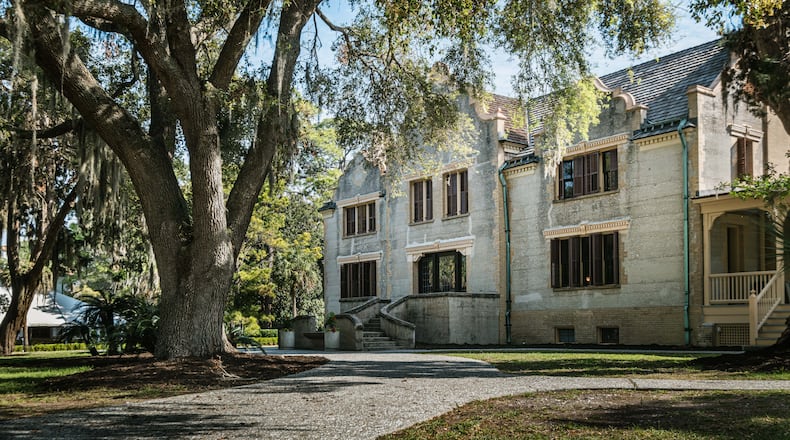JEKYLL ISLAND ― It is one of 11 historic residences preserved as part of the Jekyll Island Club, the preeminent wintertime refuge for America’s wealthiest families a century ago.
Many bicycling visitors to the national historic landmark district pass the 12,000-square-foot dwelling without stopping, moving on to other architectural wonders nearby. The clubhouse with its iconic turret. Opulent manors such as Crane Cottage. The bygone retreats of tycoons and moguls with names still familiar today — Rockefeller, Morgan, Astor and Vanderbilt, all club members.
Hollybourne Cottage was the Georgia coastal haven of a lesser-known industrial titan. While the nerdiest of civil engineers might know of Charles Stewart Maurice, an innovative bridge builder, his name doesn’t grace a famed New York tourism destination or a prestigious university.
But Hollybourne houses its own exceptional story — one now being told for the first time in decades thanks to a restoration project.
Credit: Justin Taylor for The Atlanta Journal-Consititution
Credit: Justin Taylor for The Atlanta Journal-Consititution
Hollybourne is the only Jekyll cottage with walls of tabby, a building material made from burning oyster shells that is unique to the Georgia and South Carolina coasts.
It also is the only club home with a kitchen, a feature added because the Maurice family often arrived at Jekyll before Christmas, the opening of the clubhouse dining room, and stayed late into the spring, weeks after the first bloom of the island’s Cherokee roses, which signaled the club’s seasonal closure.
What’s more, the cottage, built in 1890 for $19,000, is an engineering marvel. Maurice, whose bridges spanned the Mississippi and Hudson rivers, insisted on the use of bridge girders in the attic attached to heavy ceiling beams to support the floors below. The cavernous dining room and parlor on the first floor lack load-bearing walls or pillars.
Credit: Photo courtesy of the Jekyll Island Authority
Credit: Photo courtesy of the Jekyll Island Authority
Those rooms, along with the rest of the first-floor spaces, opened for public tours in March. One of five Jekyll cottages that serve as a house museum, Hollybourne has interactive exhibits, such as a teapot in the kitchen that tells a recorded history lesson when a visitor opens its lid.
The approach is one borrowed from the great Walt Disney, according to Will Wagner, the historic resources director for the Jekyll Island Authority, the state entity that manages the island.
“You can teach someone anything so long as you don’t tell them you are teaching them,” he said.
Credit: Justin Taylor for The Atlanta Journal-Consititution
Credit: Justin Taylor for The Atlanta Journal-Consititution
Hollybourne’s most important story is one of survival. Earlier this century, JIA experts noted that the tabby walls had begun to separate from the superstructure and closed it out of safety concerns. The Maurice family and other club members lost their Jekyll cottages when the state bought the entire island and turned it into a state park in 1942, and moisture and termites weakened the wood-frame home over the decades that followed.
The preservationists feared that Hollybourne would soon become a ruin like Jekyll’s other historic tabby structure, Horton House. Sections of that home’s exterior walls still stand on the north end of the island across from Jekyll’s small airport.
But Hollybourne was built nearly 150 years later than Horton House, which dates to Georgia’s colonial era. Maurice’s decision to build Hollybourne out of tabby is said to have been inspired by his interest in the Horton House, which was disintegrating by the time of his first visit in the late 1880s.
Hollybourne was “on its way” to becoming Jekyll’s second tabby ruins, according to Wagner, until undergoing a successful restabilization completed in 2018. The renovation followed and, on March 8, Hollybourne reclaimed its standing as an open-to-the-public venue along millionaire’s row.
Hollybourne is the featured attraction on two of the daily Jekyll Historic District trolley tours. The tours and the Mosaic Museum generate $1.5 million annually, funds the JIA reinvests in restoring the cottages and refreshing or, as Wagner calls it, “reimagining” the historical and educational offerings inside them.
Next up is prepping the second floor of the Hollybourne Cottage for tours and reimagining DuBignon Cottage, the oldest along millionaire’s row and named for the Jekyll Island Club’s founder, John Eugene DuBignon.
Editor’s note: “Dispatches” are occasional snapshots of people, places, scenes or moments from around Georgia that our reporters come across. They aim to be immersive and aren’t always tied to a news event.
Hollybourne Cottage tours are offered twice a day, at 10:30 a.m. and 2:30 p.m., seven days a week. Tickets are $20 for adults and youth over the age of 13 and $15 for kids ages 4 to 12. Children under age 3 are free. Purchase tickets online at jekyllisland.com/history/tours/hollybourne/. The tours depart from the Mosaic museum at 100 Stable Rd, Jekyll Island, GA 31527.
Credit: Justin Taylor for The Atlanta Journal-Consititution
Credit: Justin Taylor for The Atlanta Journal-Consititution
About the Author
Keep Reading
The Latest
Featured







